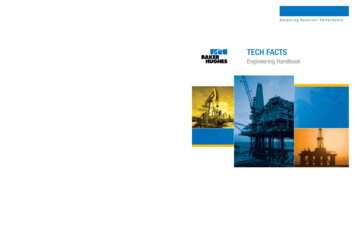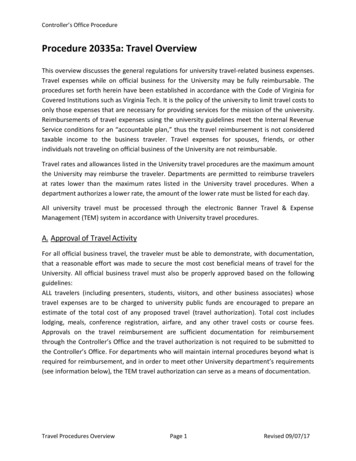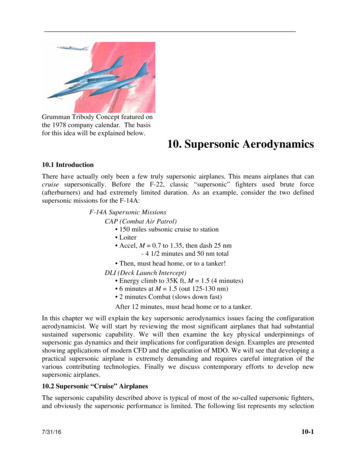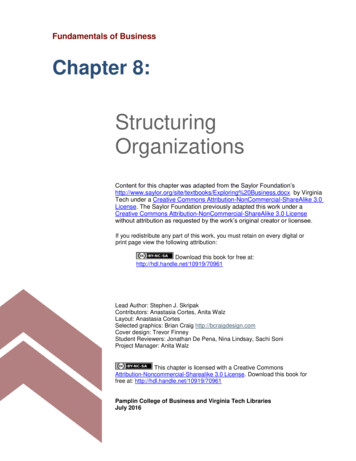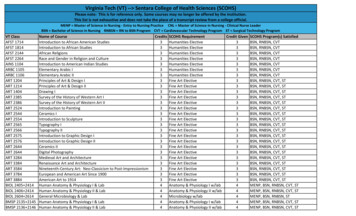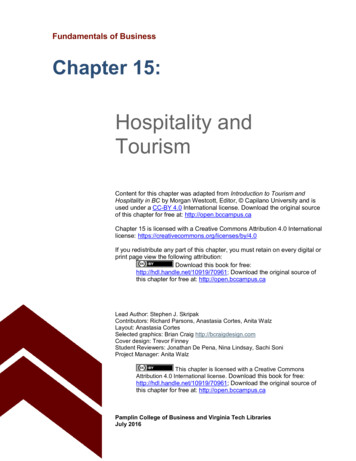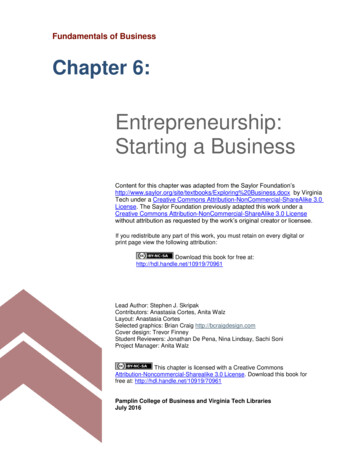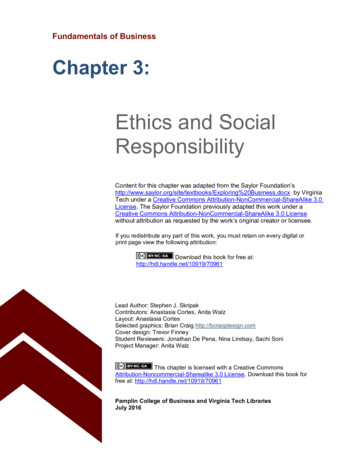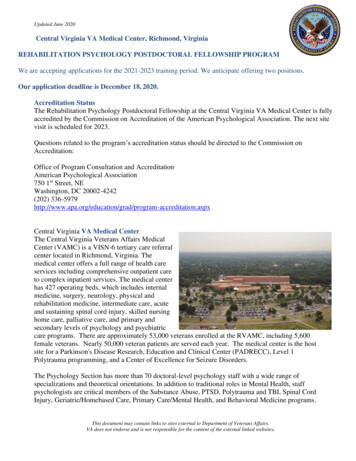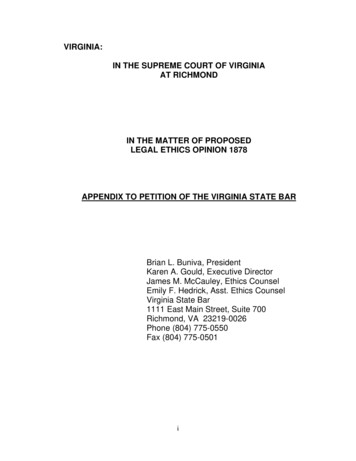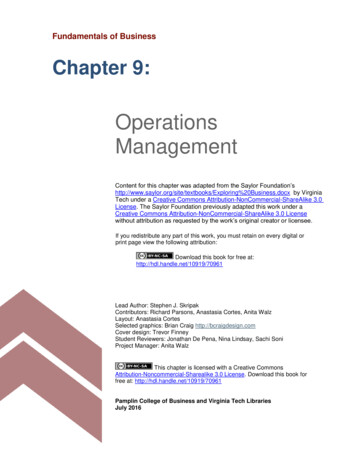
Transcription
Fundamentals of BusinessChapter 9:OperationsManagementContent for this chapter was adapted from the Saylor /Exploring%20Business.docx by VirginiaTech under a Creative Commons Attribution-NonCommercial-ShareAlike 3.0License. The Saylor Foundation previously adapted this work under aCreative Commons Attribution-NonCommercial-ShareAlike 3.0 Licensewithout attribution as requested by the work’s original creator or licensee.If you redistribute any part of this work, you must retain on every digital orprint page view the following attribution:Download this book for free at:http://hdl.handle.net/10919/70961Lead Author: Stephen J. SkripakContributors: Richard Parsons, Anastasia Cortes, Anita WalzLayout: Anastasia CortesSelected graphics: Brian Craig http://bcraigdesign.comCover design: Trevor FinneyStudent Reviewers: Jonathan De Pena, Nina Lindsay, Sachi SoniProject Manager: Anita WalzThis chapter is licensed with a Creative CommonsAttribution-Noncommercial-Sharealike 3.0 License. Download this book forfree at: http://hdl.handle.net/10919/70961Pamplin College of Business and Virginia Tech LibrariesJuly 2016
Chapter 9Operations ManagementLearning Objectives1) Define operations management and discuss the role of theoperations manager in a manufacturing company.2) Describe the decisions and activities of the operationsmanager in overseeing the production process in amanufacturing company.3) Explain how to create and use both PERT and Gantt charts.4) Explain how manufacturing companies use technology toproduce and deliver goods in an efficient, cost-effectivemanner.5) Describe the decisions made in planning the product deliveryprocess in a service company.6) List the characteristics that distinguish service operations frommanufacturing operations and identify the activitiesundertaken to manage operations in a service organization.7) Explain how manufacturing and service companies alike usetotal quality management and outsourcing to provide value tocustomers.200Download this book for free at:http://hdl.handle.net/10919/70961Chapter 9
The Challenge: Producing Quality Jetboards9.1: The PowerSki Jetboard. To see it in action, visit the company’s Website at http://www.powerski.com/. Watch the videos that demonstrate whatthe Jetboard can do.The product development process can be complex and lengthy. It took sixteen years forBob Montgomery and others at his company to develop the PowerSki Jetboard, and thisinvolved thousands of design changes. It was worth it, though: the Jetboard was an exciting,engine-propelled personal watercraft - a cross between a high-performance surfboard and acompetition water-ski/wakeboard that received extensive media attention and rave reviews. Itwas showered with honors, including Time magazine’s “Best Invention of the Year” award. 1Stories about the Jetboard appeared in more than fifty magazines around the world, and it wasfeatured in several movies, over twenty-five TV shows, and on YouTube.2Montgomery and his team at PowerSki enjoyed taking their well-deserved bows for thejob they did designing the product, but having a product was only the beginning for thecompany. The next step was developing a system that would produce high-quality Jetboardsat reasonable prices. Before putting this system in place, PowerSki managers had to addressseveral questions.Chapter 9Download this book for free at:http://hdl.handle.net/10919/70961201
What kind of production process should they use to make the Jetboards? How large should their production facilities be, and where should they be located? Where should they buy needed materials? What systems will be needed to control the production process and ensure a qualityproduct?Answering these and other questions helped PowerSki set up a manufacturing systemthrough which it could accomplish the most important task that it had set for itself: efficientlyproducing quality Jetboards.Operations Management in ManufacturingLike PowerSki, every organization—whether it produces goods or provides services—sees Job 1 as furnishing customers with quality products. Thus, to compete with otherorganizations, a company must convert resources (materials, labor, money, information) intogoods or services as efficiently as possible. The upper-level manager who directs thistransformation process is called an operations manager. The job of operationsmanagement (OM) consists of all the activities involved in transforming a product idea into afinished product. In addition, operations managers are involved in planning and controlling thesystems that produce goods and services. In other words, operations managers manage theprocess that transforms inputs into outputs. Figure 9.2 illustrates these traditional functions ofoperations management.Like PowerSki, all manufacturers set out to perform the same basic function: totransform resources into finished goods. To perform this function in today’s businessenvironment, manufacturers must continually strive to improve operational efficiency. Theymust fine-tune their production processes to focus on quality, to hold down the costs of202Download this book for free at:http://hdl.handle.net/10919/70961Chapter 9
Figure 9.2: The Transformation Processmaterials and labor, and to eliminate all costs that add no value to the finished product. Makingthe decisions involved in the effort to attain these goals is another job of operations managers.Their responsibilities can be grouped as follows: Production planning. During production planning, managers determine how goodswill be produced, where production will take place, and how manufacturing facilitieswill be laid out. Production control. Once the production process is under way, managers mustcontinually schedule and monitor the activities that make up that process. They mustChapter 9Download this book for free at:http://hdl.handle.net/10919/70961203
solicit and respond to feedback and make adjustments where needed. At this stage,they also oversee the purchasing of raw materials and the handling of inventories. Quality control. The operations manager is directly involved in efforts to ensure thatgoods are produced according to specifications and that quality standards aremaintained.Let’s take a closer look at each of these responsibilities.Planning the Production ProcessThe decisions made in the planning stage have long-range implications and are crucialto a firm’s success. Before making decisions about the operations process, managers mustconsider the goals set by marketing managers. Does the company intend to be a low-costproducer and to compete on the basis of price? Or does it plan to focus on quality and go afterthe high end of the market? Many decisions involve trade-offs. For example, low cost doesn’tnormally go hand in hand with high quality. All functions of the company must be aligned withthe overall strategy to ensure success.With these thoughts in mind, let’s look at the specific types of decisions that have to bemade in the production planning process. We’ve divided these decisions into those dealingwith production methods, site selection, facility layout, and components and materialsmanagement.Production-Method DecisionsThe first step in production planning is deciding which type of production process isbest for making the goods that your company intends to manufacture. In reaching thisdecision, you should answer such questions as: Am I making a one-of-a-kind good based solely on customer specifications, oram I producing high-volume standardized goods to be sold later? Do I offer customers the option of “customizing” an otherwise standardized goodto meet their specific needs?One way to appreciate the nature of this decision is by comparing three basic types ofprocesses or methods: make-to-order, mass production, and mass customization. The task of204Download this book for free at:http://hdl.handle.net/10919/70961Chapter 9
the operations manager is to work with other managers, particularly marketers, to select theprocess that best serves the needs of the company’s customers.Make-to-OrderAt one time, most consumer goods, such as furniture and clothing, were made byindividuals practicing various crafts. By their very nature, products were customized to meetthe needs of the buyers who ordered them. This process, which is called a make-to-orderstrategy, is still commonly used by such businesses as print or sign shops that produce lowvolume, high-variety goods according to customer specifications. This level of customizationoften results in a longer production and delivery cycle than other approaches.Mass ProductionBy the early twentieth century, a new concept of producing goods had been introduced:mass production (or make-to-stock strategy), the practice of producing high volumes ofidentical goods at a cost low enough to price them for large numbers of customers. Goods aremade in anticipation of future demand (based on forecasts) and kept in inventory for later sale.This approach is particularly appropriate for standardized goods ranging from processed foodsto electronic appliances and generally result in shorter cycle times than a make-to-orderprocess.Mass CustomizationThere is at least one big disadvantage to mass production: customers, as one oldadvertising slogan put it, can’t “have it their way.” They have to accept standardized productsas they come off assembly lines. Increasingly, however, customers are looking for productsthat are designed to accommodate individual tastes or needs but can still be bought atreasonable prices. To meet the demands of these consumers, many companies have turned toan approach called mass customization, which combines the advantages of customizedproducts with those of mass production.This approach requires that a company interact with the customer to find out exactlywhat the customer wants and then manufacture the good, using efficient production methodsto hold down costs. One efficient method is to mass-produce a product up to a certain cut-offpoint and then to customize it to satisfy different customers.Chapter 9Download this book for free at:http://hdl.handle.net/10919/70961205
One of the best-known mass customizers is Nike, which has achieved success byallowing customers to configure their own athletic shoes, apparel, and equipment throughNike’s iD program. The Web has a lot to do with the growth of mass customization. Levi’s, forinstance, lets customers find a pair of perfect fitting jeans by going through an online fittingprocess. Oakley offers customized sunglasses, goggles, watches, and backpacks, while Mars,Inc. can make M&M’s in any color the customer wants (say, school colors) as well as add textand even pictures to the candy.Naturally, mass customization doesn’t work for all types of goods. Most people don’tcare about customized detergents or paper products. And while many of us like the idea ofcustomized clothes, footwear, or sunglasses, we often aren’t willing to pay the higher pricesthey command.Facilities DecisionsAfter selecting the best production process, operations managers must then decidewhere the goods will be manufactured, how large the manufacturing facilities will be, and howthose facilities will be laid out.Site SelectionIn site selection (choosing a location for the business), managers must considerseveral factors: To minimize shipping costs, managers often want to locate plants close to suppliers,customers, or both. They generally want to locate in areas with ample numbers of skilled workers. They naturally prefer locations where they and their families will enjoy living. They want locations where costs for resources and other expenses—land, labor,construction, utilities, and taxes—are low. They look for locations with a favorable business climate—one in which, forexample, local governments might offer financial incentives (such as tax breaks) toentice them to do business in their locales. For example, an enterprise zone is anarea in which incentives are used to attract investments from private companies.Managers rarely find locations that meet all these criteria. As a rule, they identify the206Download this book for free at:http://hdl.handle.net/10919/70961Chapter 9
most important criteria and aim at satisfying them. In deciding to locate in San Clemente,California, for instance, PowerSki was able to satisfy three important criteria: (1) proximity tothe firm’s suppliers, (2) availability of skilled engineers and technicians, and (3) favorable livingconditions. These factors were more important than operating in a low-cost region or gettingfinancial incentives from local government. Because PowerSki distributes its productsthroughout the world, proximity to customers was also unimportant.Capacity PlanningNow that you know where you’re going to locate, you have to decide on the quantity ofproducts that you’ll produce. You begin by forecasting demand for your product, which isn’teasy. To estimate the number of units that you’re likely to sell over a given period, you have tounderstand the industry that you’re in and estimate your likely share of the market by reviewingindustry data and conducting other forms of research.Once you’ve forecasted the demand for your product, you can calculate the capacityrequirements of your production facility—the maximum number of goods that it can produceover a given time under normal working conditions. In turn, having calculated your capacityrequirements, you’re ready to determine how much investment in plant and equipment you’llhave to make, as well as the number of labor hours required for the plant to produce atcapacity.Like forecasting, capacity planning is difficult. Unfortunately, failing to balance capacityand projected demand can be seriously detrimental to your bottom line. If you set capacity toolow (and so produce less than you should), you won’t be able to meet demand, and you’ll losesales and customers. If you set
operations management. Like PowerSki, all manufacturers set out to perform the same basic function: to transform resources into finished goods. To perform this function in today’s business environment, manufacturers must continually strive to improve operational efficiency. They must fine-tune their production processes to focus on quality, to hold down the costs of . Chapter 9 Download this .File Size: 1MBPage Count: 34
